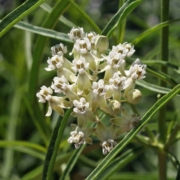
Stuck on Milkweed
There are more than 100 species of Milkweed (Asclepias species) in Mexico, the U.S. and Canada, and they get their name from the sticky white sap that seeps from leaves and stems when damaged. They occur in many types of environments, from moist sites in the Northeast to deserts of the Southwest. Milkweeds are an important nectar source for native bees, wasps, and butterflies. Some species are aggressive spreaders while others are more obedient. Milkweeds are ideal for roadsides, meadows, prairie strips, marginal cropland, and pollinator habitat where site conditions are appropriate, but many species have unique and beautiful flowers and fit nicely into the ornamental garden.
Milkweed flowers are composed of five reflexed petals (the corolla) and a corona, which arises in the middle of the corolla. The corona varies in appearance on different species but generally has five upright hoods with a pointed horn on each. Pollen occurs in waxy masses known as pollinia (pollen sacs). When bees visit the flower, the pollinia become attached to their legs. Only large-bodied bees are capable of pollinating milkweeds because they have the strength to pull out and carry the pollinia while traveling from flower to flower. You might observe small bees “stuck” in milkweed flowers because their legs have become entangled in pollinia.
Milkweeds have varying levels of toxicity and most animals will not eat them. However, Monarch caterpillars eat only milkweed plants because the Monarch has evolved to tolerate their toxins and incorporate them into its body, giving it a natural defense from predators. This means that caterpillars are specialized herbivores and cannot feed on any other plants. Consequently, Monarch females must lay their eggs exclusively on milkweed, which is why they play a critical role in the monarch’s life cycle.
Loss of habitat through mowing, herbicides, and agricultural intensification have made it more difficult for milkweed populations to persist. As a result, monarch populations have declined. To help mitigate these losses, Applewood recommends planting milkweeds and nectar sources for Monarchs. The following list will aid you in choosing the correct milkweed species for your area.









Applewood Seed Co. Unveils Verbena ‘Sweetheart Kisses’ – A Stunning All-America Selections and Fleuroselect Recognized Flower
Applewood Seed Co., an employee-owned company, proudly announces the launch of ‘Sweetheart Kisses’, a remarkable and brand new Verbena cultivar to the domestic and international flower market. It is a 2024 distinguished flower of both the All-America Selections National award and the Fleuroselect Approved Novelty status, marking a first in Applewood Seed’s history. This dual […]
Applewood Seed Co. Announces Strategic Leadership Changes to Drive Business Growth
Applewood Seed Co., an employee-owned company, the leading supplier and wholesaler of open-pollinated flower seeds in the U.S., proudly announces two pivotal promotions within its leadership team. Mary Gomane has been promoted to Vice President of Sales & Production and Joe Eenigenburg has advanced to the role of Director of Sales & Marketing. These strategic […]